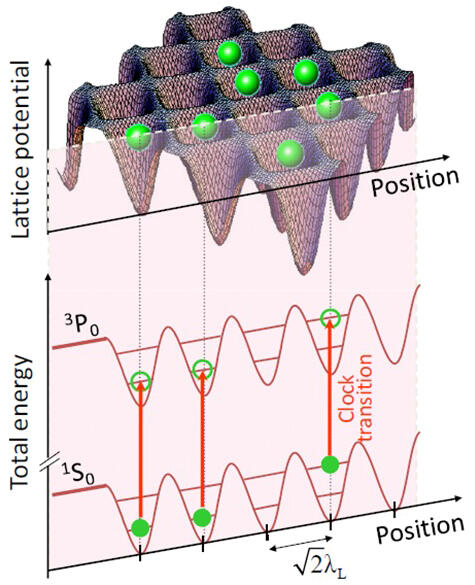Professor Hidetoshi Katori of the Graduate School of Engineering at the University of Tokyo (RIKEN team leader), in collaboration with Senior Research Scientist Masao Takamoto of RIKEN, Shimadzu Corporation, and JEOL Ltd. succeeded in developing the world's first compact, robust, ultrahigh-precision optical lattice clock with a device volume of 250 L. Miniaturization will greatly expand the range of applications of high-precision time measurement technology that uses optical lattice clocks. It is expected that this will help advance science and technology and new technological innovations for social infrastructure.

Atoms (spherical) are captured in a microscopic space (an egg-pack shaped optical lattice) created by the interference of laser light. The optical lattice consists of special laser wavelengths. The ground and excited states of the atoms are subjected to an energy shift of the same magnitude by the optical lattice laser, so that the frequency of the atomic pendulum remains unchanged, despite being in an optical electric field.
©Hidetoshi Katori, the University of Tokyo
Optical lattice clocks are a type of highly accurate atomic clock that achieves 18-digit precision, more than 100 times better than cesium atomic clocks that currently define the "second." This precision is equivalent to an error of approximately one second in 10 billion years. Because of this extremely high precision, optical lattice clocks are attracting attention as a strong candidate for the next generation "definition of the second."
In 2020, Katori and Takamoto's research group, in collaboration with Shimadzu, measured the difference in the passage of time between two optical lattice clocks (device volume: 920 L, 18-digit precision) installed on the ground floor (altitude: 0 m) and Tembo Galleria floor (altitude: 450 m) of Tokyo Skytree. By comparing the altitude difference at the two installation sites, they successfully conducted a demonstration experiment of the general theory of relativity and developed the world's first portable optical lattice clock with 18-digit precision. However, to use optical lattice clocks as future social infrastructure, devices must be further miniaturized as they are expected to be used in various environments. Furthermore, it is necessary to enable stable operation over a long period of time.
Therefore, the joint research group miniaturized a physics package for performing spectroscopy of atomic clock transitions and a laser and control system for controlling atomic trapping and spectroscopy. The physics package was jointly developed by the University of Tokyo, RIKEN, and JEOL. By incorporating coils and blackbody radiation shields for generating a spatially uniform magnetic field, which is essential for a high-precision optical lattice clock, in a vacuum chamber, they substantially reduced the size of the package and achieved high precision.
The laser and control system was jointly developed by the University of Tokyo, RIKEN, and Shimadzu. The laser and control system has an optical system which uses laser welding techniques to eliminate the need for an optical axis adjustment mechanism. Its water-cooling feature and heat pipes are used to afford thermal stability. Additionally, a control circuit is optimally mounted on the system with a high density. By virtue of the above features, the laser and control system is more compact and robust than conventional systems and can operate for long durations. Furthermore, all features are designed in a modular configuration where each feature is a replaceable module, improving maintainability during operation.
The joint research group integrated these R&D results for the development of the clock and now succeeded in developing the world's first ultra-high precision optical lattice clock device with a volume of 250 L.
The International Bureau of Weights and Measures (BIPM) plans to redefine "second" in 2030, and optical lattice clocks are one of the approaches used for this redefinition. If optical lattice clocks become the definition of "second," it is expected that they will be extensively employed as the international standard for time keeping. In this case, long-term operation will be essential for their use as social infrastructure. Realizing robust optical lattice clocks is even more important. The miniaturization of these clocks will allow them to be installed in various environments. They are expected to be applied to various research sites and applications as a future social infrastructure, such as for the precise observation of plate motions with an accuracy of several centimeters and crustal deformation (elevation change) that occurs over several hours to several years and establishment of ultrahigh-precision elevation difference measurement and positioning systems.
This article has been translated by JST with permission from The Science News Ltd. (https://sci-news.co.jp/). Unauthorized reproduction of the article and photographs is prohibited.




